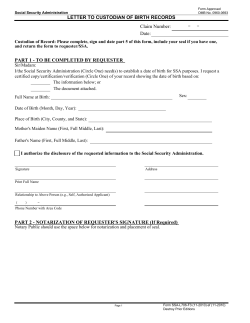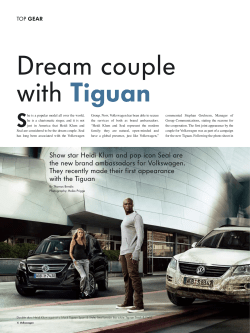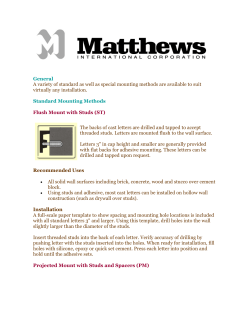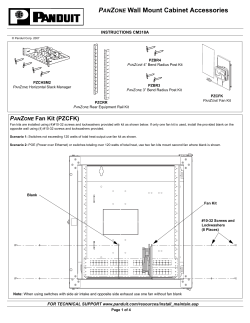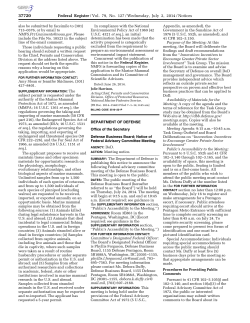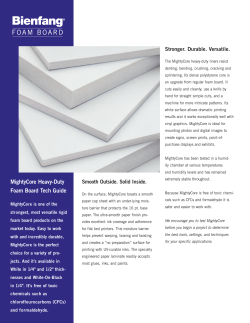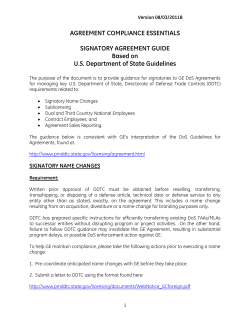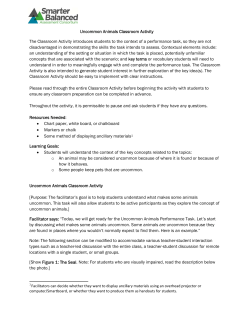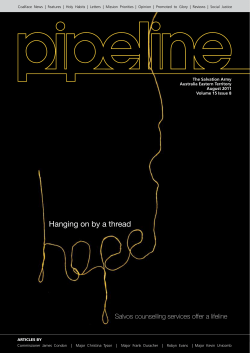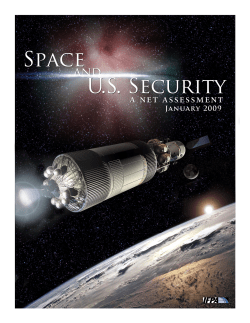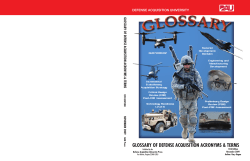
Salient Characteristics Defense Media Activity
Defense Media Activity Salient Characteristics Vendor must be a certified manufacturer of the Institute of Heraldry (IOH), as stated on the manufacturer webpage: http://www.tioh.hqda.pentagon.mil/Catalog/VendorList.aspx 1. Using the information sheet(s) from the Institute of Heraldry provide a 15" diameter, 1" thick, three-dimensional (raised lettering and design elements), color Department of Defense Seal/Coat of Arms (attachment 1) for indoor display on a wall. Quantity: 6 Material: vacuum formed plastic and resin. Mounting requirements: keyhole mounting as seen in figure 1: cut into the back of the plaque for flush mounting on a wall. 2. Using the information sheet(s) from the Institute of Heraldry provide a 15" diameter, 1" thick, three-dimensional (raised lettering and design elements), color Department of United States Army Seal/Coat of Arms (attachment 2) for indoor display on a wall. Quantity: 7 Material: vacuum formed plastic and resin. Mounting requirements: keyhole mounting as seen in figure 1: cut into the back of the plaque for flush mounting on a wall. 3. Using the information sheet(s) from the Institute of Heraldry provide a 15" diameter, 1" thick, three-dimensional (raised lettering and design elements), color Department of United States Navy Seal/Coat of Arms (attachment 3) for indoor display on a wall. Quantity: 7 Material: vacuum formed plastic and resin. Mounting requirements: keyhole mounting as seen in figure 1: cut into the back of the plaque for flush mounting on a wall. 4. Using the information sheet(s) from the Institute of Heraldry provide a 15" diameter, 1" thick, three-dimensional (raised lettering and design elements), color of United States Marine Corps Seal/Coat of Arms (attachment 4) for indoor display on a wall. Quantity: 7 Material: vacuum formed plastic and resin. Mounting requirements: keyhole mounting as seen in figure 1: cut into the back of the plaque for flush mounting on a wall. 5. Using the information sheet(s) from the Institute of Heraldry provide a 15" diameter, 1" thick, three-dimensional (raised lettering and design elements), color Department of United States Air Force Seal/Coat of Arms (attachment 5) for indoor display on a wall. Quantity: 7 Material: vacuum formed plastic and resin. Mounting requirements: keyhole mounting as seen in figure 1: cut into the back of the plaque for flush mounting on a wall. 6. Using the information sheet(s) from the Institute of Heraldry provide a 15" diameter, 1" thick, diameter, three-dimensional (raised lettering and design elements), with color gradients Defense Media Activity Seal/Coat of Arms (draft attachment 6; final will be provided upon award) for indoor display on a wall. Quantity: 7 Material: vacuum formed plastic and resin. Mounting requirements: keyhole mounting as seen in figure 1: cut into the back of the plaque for flush mounting on a wall. 7. Using the information sheet(s) from the Institute of Heraldry provide a 20" diameter, 1" thick, three-dimensional (raised lettering and design elements), with color gradients Defense Media Activity Seal/Coat of Arms (draft attachment 6; final will be provided 1 upon award) for indoor display on a wall. Quantity: 2 Material: vacuum formed plastic and resin. Mounting requirements: keyhole mounting as seen in figure 1: cut into the back of the plaque for flush mounting on a wall. 8. Using the information sheet(s) from the Institute of Heraldry provide a 24" diameter, 1" thick, three-dimensional (raised lettering and design elements), with color gradients Defense Media Activity Seal/Coat of Arms (draft attachment 6; final will be provided upon award) for indoor display on a wall. Quantity: 1 Material: vacuum formed plastic and resin. Mounting requirements: keyhole mounting as seen in figure 1: two (2) cuts into the back of the plaque for flush mounting on a wall. 9. Using the information sheet(s) from the Institute of Heraldry (enclosed) provide a 20" diameter, 1" thick, three-dimensional (raised lettering and design elements), color Department of Defense Seal/Coat of Arms (attachment 1) for indoor display on a wall. Quantity: 1 Material: vacuum formed plastic and resin. Mounting requirements: keyhole mounting as seen in figure 1: cut into the back of the plaque for flush mounting on a wall. Attachment 7 shows the image of the DoD and US Military Service Seals. 2 DEPARTMENT OF DEFENSE SEAL Description: An American bald eagle with wings displayed horizontally grasping three crossed arrows and bearing on its breast a shield of thirteen pieces Argent and Gules, a chief Azure. Above the eagle an arc of thirteen stars with alternating rays. Below the eagle a wreath of laurel to dexter and olive to sinister. On an encircling band the inscription "DEPARTMENT OF DEFENSE" at the top and "UNITED STATES OF AMERICA" at the bottom. When illustrating the seal in color, the background will be medium blue; the eagle and wreath proper; the arrows, stars and rays yellow/gold. The encircling band will be dark blue with yellow/gold edges and letters in white. Symbolism: The American bald eagle, long associated with symbolism representing the United States of American and its military establishment, has been selected as an emblem of strength. The eagle is defending the United States, represented by the shield of thirteen pieces. The thirteen pieces are joined together by the blue chief, representing the Congress. The rays and stars above the eagle signify glory, while the three arrows are collectively symbolic of the three component parts of the Department of Defense. The laurel stands for honors received in combat defending the peace represented by the olive branch. Background: The seal was originally approved on 8 October 1947 by the President for the National Military Establishment. The designation was changed to Department of Defense on 15 August 1949. Current Usage: Any request for use of the Department of Defense seal in commercial items may be referred to Directorate of Community Relations, OASD (PA) 1400 Defense Pentagon, Room 1E776, Washington, DC 20301-1400. No published policy as been established by Department of Defense concerning use of the Department of Defense seal; however, Section 701, Title 18, United States Code, prohibits use of official badges, identification cards, and other insignia except as authorized by regulation. Attachment 1 DEPARTMENT OF THE ARMY EMBLEM DISPLAY PLAQUE Background: Prior to the establishment of the Department of the Army Emblem, there was no official display item to identify the Army. The Army seal had traditionally been used to authenticate documents only and was not authorized for display. In recognizing the need to provide a display item, The Secretary of the Army approved the emblem design as the official emblem to represent the Army on 29 January 1974. Description: The Army emblem is derived from the Army seal and differs from the seal in several respects: a. The emblem is displayed in color while the seal is not. b. The emblem includes the inscription "Department of the Army" instead of the seal inscription "War Office". c. On the emblem, the American flag is on its own right (observers left) to reflect the current custom for display of flags. The Army flag pattern has been added to the other flag. d. The Roman numerals "MDCCLXXVIII" which indicate the date the Army seal was adopted, were replaced with the date "1775" to reflect the date the Army was established. Symbolism: The symbolism for the elements of the Army emblem is the same as for the Army seal with the above deviations and additions: The colors of the design elements are those traditionally associated with the ideals of the United States and of the Army. The flags are in proper colors. Blue is symbolic of loyalty, vigilance, perseverance, and truth. Red denotes courage, zeal, and fortitude. White alludes to deeds worthy of remembrance. Black is indicative of determination and constancy. Gold represents achievement, dignity, and honor. Current Usage: The reproduction of the Army emblem is authorized in publications and other printed matter of an official or quasi-official nature in Army approved films and in official Army motion pictures or television programs. The design may not be modified in any manner. It may be reproduced in its proper colors, through the use of a one-color line process, or as a line drawing. The use of the Army emblem for Attachment 2 any other purposes, including its incorporation in other items for commercial sale, will be only as authorized by The Institute of Heraldry. Attachment 2 UNITED STATES NAVY Description: On a circular background of fair sky and moderate sea with land in sinister base, a three-masted square rigged ship under way before a fair breeze with after top-sail furled, commission pennant atop the foremast, National Ensign atop the main, and the commodore's flag atop the mizzen. In front of the ship a luce-type anchor inclined slightly bendwise with the crown resting on the land and, in front of the shank and in back of the dexter fluke, an American bald eagle rising to sinister regarding to dexter, one foot on the ground, the other resting on the anchor near the shank; all in proper colors. The whole within a blue annulet bearing the inscription "Department of the Navy" at the top and "United States of America" at the bottom, separated on each side by a mullet and within a rim in the form of a rope; inscription, rope, mullet, and edges of annulet all gold. Background: The policy for use of the Navy seal and emblem is contained in SECNAV Instr 5030.4 and SECNAV Instr 5030.6. The seal design was approved by the President of the United States by Executive Order 10736 dated October 23, 1957. Request for use of the Navy emblem should be submitted in writing to Defense Printing Service, ATTN: DPSMO, 8725 John Kingman Rd Suite 3239, Fort Belvoir, VA 22060-6220. The telephone number is (703) 767-4218. Attachment 3 UNITED STATES MARINE CORPS Description: Standing upon the Western Hemisphere of the terrestrial globe containing the lines of latitude and topographical outlines of North, Central, and South America, an American Bald Eagle with wings displayed horizontally and inverted holding in his beak a scroll inscribed with the motto "Semper Fidelis", all bronze. Behind the Western Hemisphere a foul anchor bendwise sinister with stock, arms, and flukes in slight perspective, all bronze, on a scarlet background and within a dark blue band edged in gold circumscribed by a gold rope rim and inscribed "DEPARTMENT OF THE NAVY UNITED STATES MARINE CORPS" in gold letters. The central device of the seal is the emblem of the United States Marine Corps. Symbolism: The globe on the emblem signifies service in any part of the world. The eagle is our national symbol. The anchor, whose origin dates back to the founding of the Marine Corps in 1775, indicates the amphibious nature of the Marine Corps mission. Background: The design was approved by the President of the United States by Executive Order 10538 dated June 22, 1954 (The Institute of Heraldry drawing 6-1-7). The policy for use of the Marine Corps Emblem is established in Marine Corps Order #5030.3. Request for use of the Marine Corps emblem in commercial items should be submitted to Headquarters, United States Marine Corps, 2 Navy Annex, Printing and Publishing Management Section, Code ARDE, Washington, DC 20380-1775. The telephone number is (703) 614-4698. Attachment 4 UNITED STATES AIR FORCE DESCRIPTION: Shield: Per fess nebuly abased Azure and Argent, in chief a thunderbolt Or inflamed proper. Crest: On a wreath Argent and Azure an American bald eagle wings displayed and partially elevated proper in front of a cloud Argent. Seal: On a blue disk and encircling the shield and crest, an arc of thirteen stars and below the shield the inscription "MCMXLVII". On a band encircling the whole, the inscriptions "DEPARTMENT OF THE AIR FORCE" and "UNITED STATES OF AMERICA". SYMBOLISM: Ultramarine blue and yellow are the colors of the Air Force. The nebuly division of the shield represents clouds. The thunderbolt signifies the striking power through the use of aerospace. The eagle symbolizes the United States and its airpower. The white clouds behind the eagle reflect the start of a new sky. The thirteen stars represent the original thirteen colonies. The Roman Numeral MXMXLVII (1947) is the year the Air Force was established as a separate Service. The design was approved by the President of the United States on November 1, 1947. BACKGROUND INFORMATION: Request for use of the Air Force emblem in commercial items or information concerning the use of the Air Force Seal should be submitted to Headquarters, USAFHRC/RI, Maxwell AFB, Alabama 36112-6678. The point of contact is Mr. J. Godwin, Telephone (205) 953-2960. Attachment 5 DEPARTMENT OF DEFENSE DEFENSE MEDIA ACTIVITY SEAL DESCRIPTION: On a Celeste (Bluebird) colored disc, a shield blazoned: Purpure (Purple), detailed Sable (Black), a bordure Argent (Silver Gray), surmounted of another Gris (Dark Gray), the bordures counterchanged in base. The shield surmounted by a Celeste (Brittany Blue) terrestrial globe with Silver Gray landmasses and Sable grid lines and fimbriation, encircled by a diminished Celeste (Brittany Blue) annulet and three annulets Black, Purple and Silver Gray, the three annulets fimbriated Black, in chief five Yellow mullets formed in an arch, in base a Cinnamon wreath Yellow bearing Purple berries, between the wreath a bundle of five lightning bolts, bound by a ribbon of the first. All encircled by a White designation band edged Gold and inscribed”DEFENSE MEDIA ACTIVITY” around the top and “DEPARTMENT OF DEFENSE” around the bottom in Dark Blue letters. SYMBOLISM: The Defense Media Activity consolidates five media groups into one, the American Forces Information Service, the Soldier’s Media Center, U.S. Marine Corps News, Naval Media Center and Air Force News Agency. The five stars represent each of these media groups. The shield symbolizes defense and safe guarding freedom. Purple represents the joint military mission of the activity. The annulets represent the strata of air waves expanding outward into the infinite. The globe symbolizes worldwide media coverage. The annulet combined with the globe depicts a camera lens as it reflects an image of the globe. The cinnamon wreath represents success and championship of all forms of communication. The bundle of lightning bolts is a reference to the speed with which communications travel through the five media groups combined as one. Attachment 6 Attachment 7 Figure 1
© Copyright 2025

